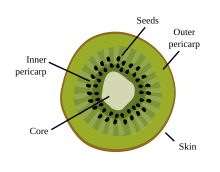Kiwifruit
Kiwifruit (often shortened to kiwi outside Australia and New Zealand), or Chinese gooseberry, is the edible berry of several species of woody vines in the genus Actinidia.[1][2] The most common cultivar group of kiwifruit (Actinidia deliciosa 'Hayward')[3] is oval, about the size of a large hen's egg: 5–8 centimetres (2–3 inches) in length and 4.5–5.5 cm (1+3⁄4–2+1⁄4 in) in diameter.[4] In the early 20th century, cultivation of kiwifruit spread from China to New Zealand, where the first commercial plantings occurred.[1] The fruit became popular with British and American servicemen stationed in New Zealand during World War II, and later became commonly exported, first to Great Britain and then to California in the 1960s.[1] In the late 1950s, a major New Zealand exporter began calling it "kiwifruit" (Māori: huakiwi)[7] after being advised by a United States client that quarantine officials might mistakenly associate the unpopular name gooseberries[8] – which grow close to the ground – with suspicion of anthrax.[13] Cultivation of kiwifruit spread from China in the early 20th century to New Zealand, where the first commercial plantings occurred.[1] After the Hayward variety was developed, the fruit became popular with British and American servicemen stationed in New Zealand during World War II.[2][15] Kiwi berries are edible fruits the size of a large grape, similar to fuzzy kiwifruit in taste and internal appearance but with a thin, smooth green skin.They are primarily produced by three species: Actinidia arguta (hardy kiwi), A. kolomikta (Arctic kiwifruit) and A. polygama (silver vine).[17][18] Actinidia chinensis (yellow kiwi or golden kiwifruit) has a smooth, bronze skin, with a beak shape at the stem attachment.The yellow fruit obtains a higher market price and, being less hairy than the fuzzy kiwifruit, tastes better without peeling.[31] Once a kiwifruit is ripe, however, it is preserved optimally when stored far from other fruits, as it is very sensitive to the ethylene gas they may emit, thereby tending to over-ripen even in the refrigerator.[36] Scientists reported they had worked out the strain of PSA affecting kiwifruit from New Zealand, Italy and Chile originated in China.[43] Much of the breeding to refine the green kiwifruit was undertaken by the Plant & Food Research Institute (formerly HortResearch) during the decades of '1970–1999'.[14] Kiwifruit may be eaten raw, made into juices, used in baked goods, prepared with meat or used as a garnish.[46] Sliced kiwifruit has long been used as a garnish atop whipped cream on pavlova, a meringue-based dessert.Traditionally in China, kiwifruit was not eaten for pleasure, but was given as medicine to children to help them grow and to women who have given birth to help them recover.[1] Raw kiwifruit contains actinidain (also spelled actinidin) which is commercially useful as a meat tenderizer[47] and possibly as a digestive aid.In a 100-gram (3.5 oz) amount, green kiwifruit provides 255 kilojoules (61 kilocalories) of food energy, is 83% water and 15% carbohydrates, with negligible protein and fat (table).
A = A. arguta , C = A. chinensis , D = A. deliciosa , E = A. eriantha , I = A. indochinensis , P = A. polygama , S = A. setosa .









Kiwifruit (TV series)Yellow kiwifruitwoody vinesActinidiacultivarActinidia deliciosahen's eggSong dynastyWorld War IICalifornianurserywalnutsgooseberriesMāoriquarantineanthraxnickname for New ZealandersKiwifruit industry in New ZealandTraditional ChineseSimplified ChineseStandard MandarinHanyu PinyinYue: CantoneseJyutpingcultivatedA. deliciosaA. chinensisA. argutaA. kolomiktaA. melanandraA. polygamaAvondaleActinidia argutaA. kolomiktaA. polygamagrowing seasonGold kiwifruitintellectual propertySichuan provincerootstockpollinatorscrossbreedsseedlingscultivarsasexuallydioeciouspollinatehoney beessaturation pollinationethylenePseudomonas syringaeBay of Plenty RegionNew ZealandGreeceFAOSTATtonnesYangtze RiverSichuanAustralasiaZespribreedingPlant & Food ResearchAntwerpBelgiumpavlovaEnergyCarbohydratesSugarsDietary fiberProteinVitaminsVitamin A equiv.luteinzeaxanthinThiamine (B1)Riboflavin (B2)Niacin (B3)Pantothenic acid (B5)Vitamin B6Folate (B9)Vitamin B12CholineVitamin CVitamin EVitamin KMineralsCopperMagnesiumPotassiumSeleniumSodiumthe National Academieswhipped creamactinidainmeat tenderizerdigestive aidgelatinfood energymicronutrientsalpha-linolenic acidomega-3 fatty acidcarotenoidsprovitamin Abeta-caroteneallergenwheezinganaphylaxisTimber PressLos Angeles TimesWayback MachineA. R. FergusonBibcodeUnited States Food and Drug AdministrationNational Geographic
